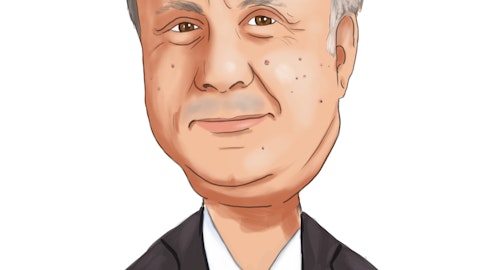They just feel we need to have more data to prove that. So therefore, they want to align on an agreed upon trial to provide that data. And therefore that discussion together with them is very important to see what are they seeking in addition to what we provided? So we should align on what should be provided, what should be sufficient for an approval? That’s what a SPA means. So going into that meeting, I think we are going to get an expedited meeting. We are getting the indication from agency that they want to have this meeting very fast. So they’re showing interest and supporting us being able to have another trial very soon to talk operational. I’ll ask Stacy also to comment. Stacy?
Stacy Lindborg: Yes. William, thank you for the comment and your question. And I think when we step back and we look at what we have before us, certainly when we brought forward our product, we believe and we still believe in our data and we believe that there was a discussion that should happen around the efficacy and safety and the appropriateness, given regulatory flexibility. But at the end of the day, when we look forward, one of the strongest positions and the things that we can do is we can execute on a trial design, leveraging the learnings that have occurred and we can read out a trial that meets its endpoints. And so what you see us doing is really doubling down. We understand our product. We have a lot of information that we believe gives us a lot of confidence in our ability to deliver this trial.
And so what we’re focused on is bringing forward a product that’s straightforward in this next trial that makes the regulatory process certainly more conventional and the next time around, certainly much more streamlined and smooth. So that’s what I think of when I think about what’s different next time. And drug development is incredibly complicated. We always learn things in our endeavors when we’re tackling very tough diseases. And I think in the setting of this last Phase 3 program, certainly there were things that the community did not appreciate and did not understand. And we now have those learnings that we take forward to this next trial design.
Unidentified Analyst: Thank you very much. For those of us that have ALS patients in our lives, have lost family and friends, I just wanted to say thank you to both of you and thank you for fighting the good fight for us.
Chaim Lebovits: No, thank you for your ongoing support many years, really appreciate that.
Operator: Thank you very much.
Chaim Lebovits: Next question please, Jenny. We have time for one more.
Operator: Your next question is from Daniel Walker [ph] who is a private investor. Daniel, your line is live.
Unidentified Analyst: On manufacturing, you mentioned that the recent BrainStorm Town Hall meeting that BrainStorm has successfully manufactured 500 potent products. But I think there have been some questions about BrainStorm’s ability to manufacture. Can you just comment on that? And then also moving forward, how will the clean rooms be managed? Will it be commercial [ph]? Will it be the academic centers? Maybe you could just comment a little bit on that.
Chaim Lebovits: Thank you very much, Daniel, for this question. So we did have quite a few centers where we really produced as you know for the Phase 2 and Phase 3 trials given the academic centers and the commercial centers are only for the EAP. Going forward, it’s first a financial question. The academic centers are cheaper than the commercial center to operate. And on the other hand, you do want to have a site that once you’re successful with the trial, you should have a commercial site ready. So we’re going to balance that timing wise. Maybe we’ll start with academic and then for the second part of the trial do a commercial site so we can gain from the cheaper cost earlier and then simultaneously be able to have the commercial site ready once the trial is done. Does that answer your question?
Unidentified Analyst: That does. And I guess with the SPA, how do you ensure that this go around, because the FDA was quite critical of the manufacturing at the ADCOM. How do you ensure moving forward, though, that there is alignment, not only on the SPA but also in addition to the manufacturing so that at the time you resubmit the BLA, they feel confident in the manufacturing because obviously there’s the difference between manufacturing at the trial level compared to actually at the time of commercialization?
Chaim Lebovits: Thank you. That’s very helpful. You clarified the question even more. So the answer is, FDA agreed to have discussions with us while we do the trial on the same patients to come to alignment. And as I’ve said previously, we have come to alignment on many of the same issues, if not most, but some of them it takes longer to do those qualification tests, which we are continuing to do those that are critical. But yes, FDA will have with us separate conversations with the same team and separately from the clinical team.
Unidentified Analyst: Excellent. Thank you so much. And then just lastly, I was wondering if you could just expand on the exosome technology. I know you’re working on capitalizing that. Can you or Stacy just comment very briefly on what is that technology? And why that might be interesting and compelling to pharma or biotech?
Chaim Lebovits: Yes. You mentioned Stacy, so I’ll ask Stacy to talk to that, of course. And if I am needed, I’ll add on. Stacy?



